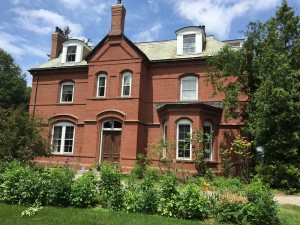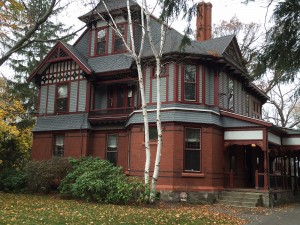The Victorian era roughly corresponds to the time when Queen Victoria ruled Britain (1837-1901) during which period the styles known as Victorian were used in construction. During this time, industrialization brought many innovations in architecture.
There are a wide variety of Victorian styles, each with its own distinctive features. However, many elements of what is typically termed “Victorian” architecture did not become popular until later in Victoria’s reign. Victorian houses are architecturally commonly referred to as the Victorian Style but this “style” is really a period in history.
In the United States, “Victorian” architecture generally describes styles that were most popular between 1860 and 1900. A list of the most common Victorian styles includes Second Empire (1855–85), Stick-Eastlake (1860–1890), Folk Victorian (1870-1910), Queen Anne (1880–1910), Richardsonian Romanesque (1880–1900), and Shingle (1880–1900).
Architecture during the Victorian era was very elaborate, romantic, and emotional. The architecture of the house signaled that the owner had great wealth. Victorian houses were very large with many small rooms, with each room having a particular function. They had ballrooms, morning rooms, sitting rooms, libraries, piano rooms, etc. Victorian houses often were set in the middle or towards the back of lots.
Among the most common identifying features of Victorian houses were: • Asymmetrical facade; • Steeply pitched roofs of irregular shape, usually with dominant front-facing gable;
 Victorian house in Milton, Mass: Abbot performed brick restoration on the north (left) side and west (front) sides of the house in separate phases. As evidenced by the photograph, the appearance of the brickwork is identical demonstrating the consistency and quality of the workmanship throughout the both phases.
Victorian house in Milton, Mass: Abbot performed brick restoration on the north (left) side and west (front) sides of the house in separate phases. As evidenced by the photograph, the appearance of the brickwork is identical demonstrating the consistency and quality of the workmanship throughout the both phases.• Textured shingles to avoid smooth-walled appearance; and • Partial or full-width asymmetrical porch, usually one story high and extended along one or both sidewalls.
Brick facades were often incorporated into various Victorian home designs to provide character and durability. Ornamental wood details and brick surrounds were utilized to enhance the aesthetic value.
Based on its rich history, Abbot is ideally suited to take on the challenges of restoring brick Victorian style homes, and was recently given the opportunity to perform restoration work at two brick Victorian homes in the Greater Boston area.
The first is a Victorian house in Milton, Mass. Built in 1853, this charming house has 5 bedrooms and 3 bathrooms, sits on a 1.1-acre lot, and has 6460 s/f of living space.
The owner was introduced to Abbot in the fall of 2014 when he observed of an Abbot restoration project of an old school building on the campus of the Massachusetts General Hospital. The owner was so enthusiastic about the similarities of the school building to his brick Victorian home that he contacted Abbot for a consultation. Following the consultation, the owner decided to select Abbot to restore his home.
The scope of the entire project consisted of 100% repointing and replacement of the deteriorated brownstone with precast concrete to match the color, shape, and size of the original brownstone. The owner elected to phase the work over a four-year span, completing phases 1 and 2 over 2014-2015, with two additional phases to be completed in 2016 and 2017.
 Victorian house in West Newton, Mass.: Abbot was contracted to cut and point all of the brick, seal around the perimeter of the windows, and perform masonry work on the foundation.
Victorian house in West Newton, Mass.: Abbot was contracted to cut and point all of the brick, seal around the perimeter of the windows, and perform masonry work on the foundation.In phases 1 and 2, Abbot cut and pointed all of the brick, replaced some of the brownstone window sills and headers, and replaced the stones under some of the windows on the north (left) and west (front) sides of the house. Significantly, Abbot was able to formulate the mortar to match the original color used on the building.
The second Victorian house, built in 1880, is located in West Newton, Mass. Constructed of masonry and wood, this house features 7 bedrooms and 5 baths, and has 6053 s/f of living area.
Feeling that the house needed some brick masonry maintenance work, the owners researched the Internet, found Abbot’s new web site (www.abbotbuilding.com), and were impressed with Abbot’s experience with historic masonry work. The owners contacted Abbot in the fall of 2015 to provide an evaluation and a cost estimate for the project. Abbot was then contracted to cut and point all of the brick, seal around the perimeter of the windows, and also perform masonry work on the foundation.
Significant to both projects, Abbot resourced the mortar to match the existing colors, and carefully removed the old mortar between the narrow joints to avoid damaging the brick facades. To assure that the brick would not be damaged during the restoration, Abbot employed an advanced technology vibrating knife with a diamond tip to carefully cut out the mortar.
Abbot’s rich history in masonry restoration affords the firm the ability to expand its services to not only restore commercial and institutional properties, but also high style brick Victorian private residences.
Abbot Building Restoration has a wealth of experience in historic masonry restoration work. Among its recent projects are:
• Peabody Essex Museum, Salem, MA -Philips Library-Plummer Hall – brick façade restoration -Gardner Pingree House –restoration of brownstone entrance -Cotting Smith Assembly House - Historic restoration of front brownstone curbing
• New Hope Baptist Church, South End, Boston, MA -Restoration of the historic tower
•African Meeting House, Beacon Hill, Boston, MA -Historic masonry restoration
Michael Norman is president of Abbot Building Restoration Co., Inc., Boston. Harlan Polishook, marketing consultant to Abbot, contributed to the content of this article.
 (1).png)








